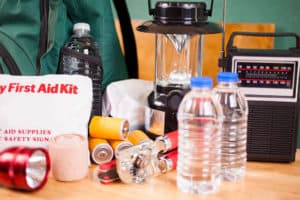When I look at different sailboats, I find myself wondering about their average and maximum speeds. Do you wonder the same thing? If yes, this article is for you.
So, how fast do racing sailboats go? Regular sailboats go at an average speed of 4 to 7 knots (4.5 to 8 mph). Racing sailboats go up to 15 to 20 knots (17 to 23 mph). Some boats, like Paul Larsen’s Vestas Sailrocket 2, reached a speed of 65.45 knots (75.32 mph or 121.22 km/h).
These numbers are just for your reference. The exact speed of each sailboat greatly differs, depending on different factors. If you want to look more into this topic, read on!
Why Your Boat’s Speed Matters in Sailing?
1. It Gives You an Adrenaline Rush
Did you ever experience adrenaline rushing throughout your body as you cross the finish line? Or, the pure satisfaction of a come-from-behind win? Those emotions can’t be beat.
2. Allows You to Use Polar Plots
The speed of a sailboat is not only important because of the obvious reasons (for the adrenaline rush, know how fast you’re going, etc.). Its speed also allows you to use a polar plot.
A polar plot is a diagram that determines the maximum speed a sailboat can travel at a given wind speed and heading (of the boat).
3. Getting to Your Destination on Time
Figuring out how fast your sailboat needs to be is important for planning your trip, so you get to where you’re going right on time or even earlier. Your boat’s speed will determine the distance it can cover in a day.
4. To Win the Race
Well, this one’s a no-brainer. If you want a fool-proof method of boosting your speed, get the fastest sailboats you could possibly buy (more on that later). But speed and having the fastest boat are not the only things that will make you win races. You and your crew also have to be extremely good.
Check out the video below to the speed of Alain Thébault’s record sailing, which reached speeds up to 41.69 knots (48 mph)!
Some Factors That Influence a Sailboat’s Speed
1. Hull Type
The hull is the watertight part of a sailboat that skims along or rides almost on top of the water. The hull type of a sailboat is one of the most crucial factors in determining its speed.
Three types of sailboat hulls:
a) Monohull – As the name hints, a monohull is a sailboat with a single hull. It’s valued for its extreme stability that’s virtually impossible to capsize.
The fastest monohull sailboat in the world, the Volvo Ocean 60 (V.O.60), has a maximum speed of 36 knots (around 41.4 mph).
b) Catamaran (or “cat”) – A catamaran sailboat features one hull on each side, both equal in size. It’s faster (compared to a monohull), so you can reach your destination in record time and avoid bad weather.
Depending on the type (sport, cruising, racing, power cruising, and SWATH), catamarans can go as fast as 15 knots (17.26 mph) to 70 knots (80.55 mph).
c) Trimaran (or double-outrigger) – A trimaran sailboat could easily cruise at speeds of 15 knots (17.26 mph) to 18 knots (20.71 mph).
This type of sailboat features three hulls: a narrow main hull and two smaller outrigger hulls (also called floats). Most trimaran sailboats are used as merchant vessels, warships, and recreation or racing boats.
2. Length Size
The waterline is the area of the hull that touches the water surface. It serves as a reference mark for the maximum depth a boat could be submerged when carrying cargo.
In theory, the greater the length of the waterline, the faster the sailboat can sail. This is because it takes longer for the bow and stern waves to form a single wave.
How it works:
As the sailboat moves through the water, it pushes the water out of the way and creates two waves: one at the front part of the hull (bow) and one at the back part of the hull (stern).
These waves will eventually meet and become one wave, which results in the formation of a trough that’s so deep that the sailboat cannot move any faster. It’s at this point that the sailboat has reached its maximum speed or “hull speed.”
However, some boaters believe hull speed is a myth. Length alone doesn’t determine a boat’s maximum speed. Resistance (which depends on the hull’s shape) and power (coming from the sails) also play major roles.
3. Your Skills
Sailboat racing has become increasingly competitive and complicated (due to more advanced equipment).
Sure, you can use the engine to power through adverse environmental situations, but you need to be highly skilled if you want to sail your boat three times faster than the wind. Proper training and experience will do that for you.
4. Technique and Tuning
Technique and tuning play a big role in the speed of your sailboat. Tuning is about preparing your boat to be as easy, efficient, fast, and safe as possible to sail.
Meanwhile, sailing techniques completely vary depending on the way the sailboat is rigged. One of the basic principles a sailing instructor will show you is how to sail with the wind.
This technique is also called “running before the wind”, which brings us to the next part of this article.
Can Sailboats Go Faster than the Wind?
The short answer is yes. This is particularly true for catamaran sailboats, ice boats, and a few monohull sailboats for racing.
Here’s the longer answer:
Sailboats harness two types of wind to do this: apparent wind and true wind.
Have you ever tried riding a motorcycle when there’s no wind?
The wind you feel on your face as you ride your motorcycle is called the apparent wind. As you go faster, the apparent wind becomes stronger.
Under ideal environmental conditions, the apparent wind is stronger than the true wind (the wind that’s not affected by your movement). However, if you’re riding your motorcycle at 12 mph when there’s a gentle breeze at 12 mph behind you, the apparent wind and true wind will cancel one another out.
So, how does this relate to propelling your boat forward, to go faster than the wind?
The sails of your boat “feel” the same wind (apparent wind) you felt when you were riding your motorcycle with no wind whatsoever. It takes advantage of this type of wind to help it go faster.
Remember, the faster your boat sails, the stronger the apparent wind becomes. Thus, the faster your boat sails.
What Are the Fastest Sailboats in the World?
How fast do racing sailboats go? Check out these super fast sailboats, which fly through the water.
1. Vestas Sailrocket 2
Paul Larsen’s Vestas Sailrocket 2 competed in the B-class (150-235 square feet of sail) in 2012. The team was successful in beating the previous record at a speed of 65.45 knots (75.32 mph).
What’s the secret to their success? By traveling in the direction opposite to the wind.
2. l’Hydroptère
In 2009, the l’Hydroptère broke the sailing speed record by reaching a speed of 52.86 knots (60.83 mph). It was the first hydrofoil-based experimental trimaran to cross an ocean (from LA to Honolulu).
It was designed by the French Alain Thébault and French-based architectural firm VPLP design (Van Peteghem Lauriot-Prévost).
3. Banque Populaire V
At 40 meters (approximately 131 feet) long, the Banque Populaire V (Spindrift 2) is considered the biggest racing trimaran sailboat in the world. It holds a lot of records.
For example, it’s the fastest boat to cross the North Atlantic (New York City-Lizard Point) with an average speed of 33.41 knots (38.45 mph).
4. IDEC 3 (formerly the Groupama 3)
The IDEC 3 or Groupama 3 is another sailing trimaran. From 2007 to 2009, it was able to hold the transatlantic record. It was also a Jules Verne Trophy holder (2010). The ten-man crew was able to sail around the world within 48 days at a speed of 18.76 knots (21.59 mph).
On May 2009, it traveled the Trans-Mediterranean at an average speed of 26.04 knots (29.97 mph).
5. GC32 Version 2
The GC32 Version 2 is a hydrofoiling catamaran made of carbon fiber, and it was designed by Dr. Martin Fischer and manufactured by the Dubai-based Premier Composite Technologies (PCT).
This boat is so light that it seems to fly as it accelerates to its maximum speed of 40 knots (46 mph). Compared to America’s Cup catamarans, the GC32 has considerably bigger foils. (The foils are attached to the boat’s hull.
They have a curved or flat wing-like surface that’s intended to provide extra lift to the moving boat).
Conclusion – How Fast Do Racing Sailboats Go?
So how fast do racing sailboats go? Most sailboats go as fast as 7 knots (8mph). Racing sailboats can easily go 15 to 20 knots (17 to 23 mph). The record holders go much faster such as Paul Larsen’s Vestas Sailrocket 2, which reached a speed of 65.45 knots (75.32 mph or 121.22 km/h).
The speed of sailboats greatly varies. Many factors make up the average speed and top speed. These factors include the materials, design, hull type, length size, environmental conditions, operator skills, and experience, including techniques and tuning.
If you’re new to sailing, it’s a good idea to attend hands-on boating courses offered by various organizations, such as the National Safe Boating Council (NSBC), United States Power Squadrons (USPS), United States Sailing Association, and sailing schools in your country. These courses will help teach you how to go faster in a safe manner.
Related reading:




![Read more about the article Microskiff Boats [What Are They? And the Best Microskiffs]](https://boatinggeeks.com/wp-content/uploads/2021/07/microskiff-300x200.jpg)
![Read more about the article Trailerable Houseboats [What Are They? and Best Trailerable Houseboats]](https://boatinggeeks.com/wp-content/uploads/2021/07/trailerable-houseboats-300x200.jpg)